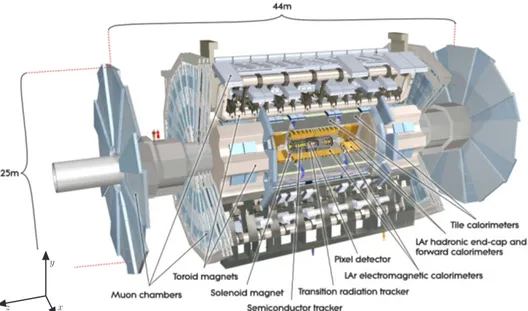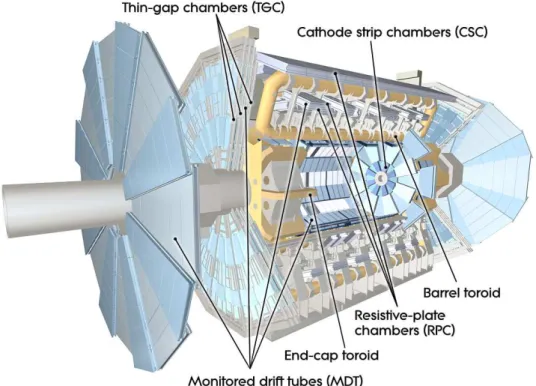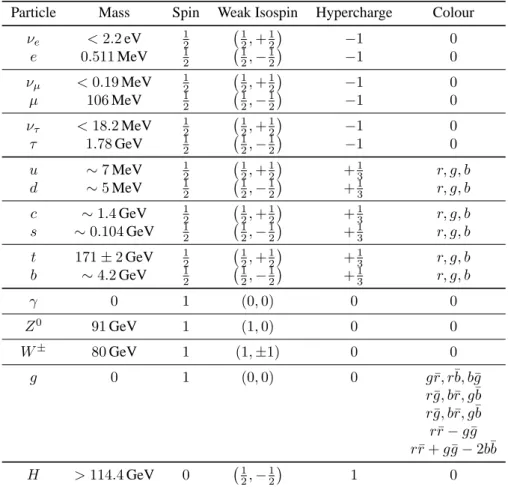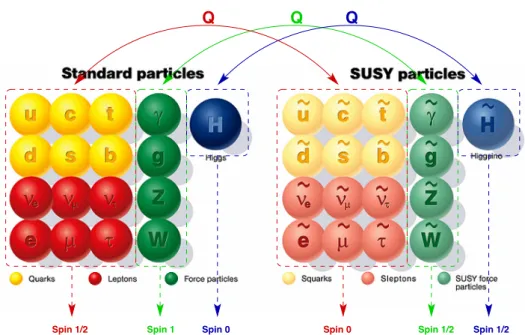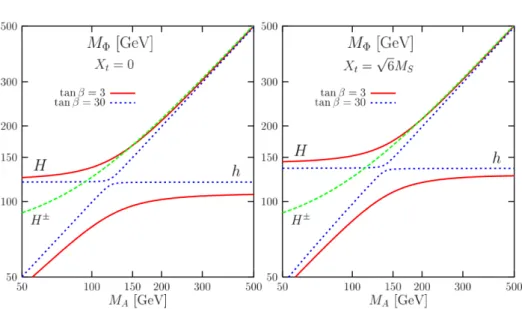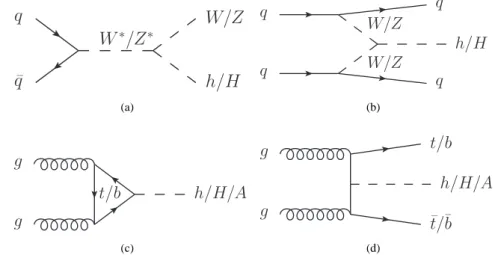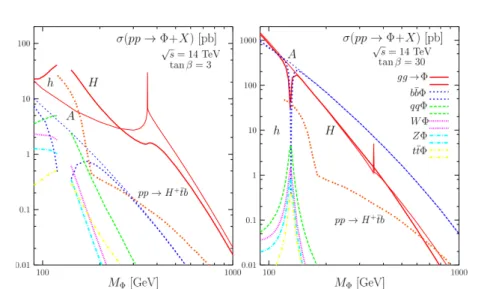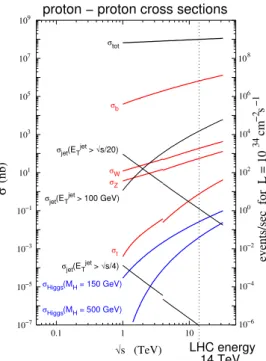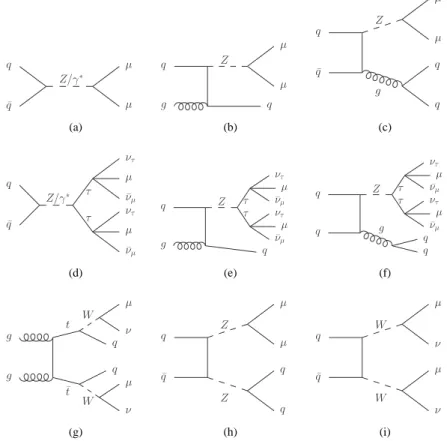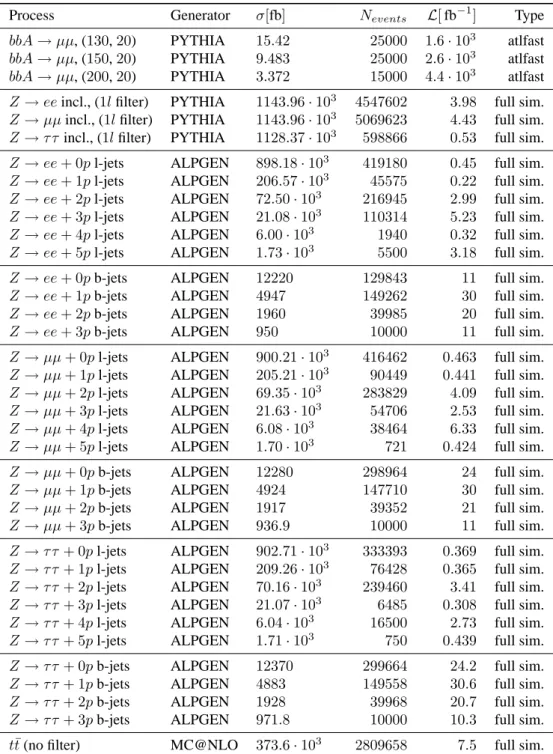W ERNER -H EISENBERG -I NSTITUT
MPP-2009-211
Measurement of the µ
+µ
−Background for Neutral MSSM Higgs Searches with the ATLAS Detector
Sebastian Stern
Diplomarbeit
eingereicht am Physik Department der Technischen Universit¨at M¨unchen
M¨unchen, 2009
F¨ohringer Ring 6 · 80805 M ¨unchen
P HYSIK -D EPARTMENT
Measurement of the µ + µ − Background for Neutral MSSM Higgs Searches with
the ATLAS Detector
Diplomarbeit von
Sebastian Stern
3. November 2009
The subject of this work is the development of a data-driven method for the background estimation for neutral MSSM Higgs searches in the decay channelh/H/A→µ+µ−. The method employs signal-free control samples from thee+e−ande±µ∓final states and is based on the vanishing decay rateh/H/A→e+e−. In contrast, for the background pro- cesses the decay rates into electrons and muons are equal at particle level. Differences between the electron and muon final states at reconstruction level arising from the detector response and the presence of Bremsstrahlung and final state radiation are studied in de- tail. The accuracy of the method is evaluated for the dominant background contributions fromZ boson andt¯tdecays. Detector-related systematic uncertainties concerning muon, electron and jet reconstruction are taken into account. Finally, the presented method for the background estimation is used to evaluate the exclusion limits at a confidence level of 95 %.
I would like to thank all the people who supported me during the work on my diploma thesis.
First of all, I want to thank PD Dr. Hubert Kroha for giving me the chance to do my diploma thesis in the MDT group at the Max Planck Institut f¨ur Physik. I thank him for his help and support during the last year and for his thorough corrections of my work.
I want to express my greatest thanks to my immediate supervisor Dr. Sandra Horvat, for the huge amount of time she spent on discussing my results, helping me to focus on the essentials and guiding me through the whole year. Many thanks for the days and nights she spent during the last weeks to correct my thesis and making it possible to finish in time.
I also want to thank all the members of the MDT group for the great working atmosphere.
It’s been a pleasure, guys!
Zu guter Letzt m¨ochte ich meinen Eltern Gudrun und Karl-Heinz Stern f¨ur ihre Un- terst¨utzung danken und daf¨ur, dass sie mir mein Studium erm¨oglicht haben.
Contents 9
1 Overview 11
2 The LHC and the ATLAS Experiment 13
2.1 The Large Hadron Collider . . . 13
2.2 The ATLAS Experiment . . . 14
2.2.1 The ATLAS Coordinate System . . . 16
2.2.2 The Magnet System . . . 17
2.2.3 The Inner Detector . . . 18
2.2.4 The Calorimeter System . . . 19
2.2.4.1 Electromagnetic Calorimeter . . . 19
2.2.4.2 Hadron Calorimeters . . . 20
2.2.5 The Muon Spectrometer . . . 20
2.2.6 The Trigger System. . . 22
3 The Standard Model and its Minimal Supersymmetric Extension 23 3.1 The Standard Model of Particle Physics . . . 23
3.1.1 The Standard Model . . . 24
3.1.2 The Higgs Mechanism . . . 27
3.1.3 Tests of the SM . . . 29
3.2 The Minimal Supersymmetric Extension of the Standard Model . . . 30
3.2.1 The Concept of Supersymmetry . . . 30
3.2.1.1 Open Questions in the Standard Model . . . 30
3.2.1.2 Supersymmetry as a Possible Solution . . . 31
3.2.2 The Minimal Supersymmetric Standard Model . . . 32
3.2.3 The Higgs Sector of the MSSM . . . 36
3.2.4 Constraints on the MSSM Higgs Sector . . . 38
3.2.4.1 Theoretical Bounds . . . 39
3.2.4.2 Constraints from Direct Higgs Boson Searches . . . 39
3.3 Neutral MSSM Higgs Boson Production at the LHC. . . 40
3.4 Decay Modes of the Neutral MSSM Higgs Bosons . . . 42
4 Search for the Neutral MSSM Higgs Bosons in the Channelh/H/A→µ+µ− 47 4.1 Motivation. . . 47
4.2 Signal and Background Processes . . . 48
4.2.1 Signal . . . 48
4.2.2 Background. . . 48
4.3 Data Samples . . . 49
4.4 Detector Performance . . . 51
4.5 Event Selection . . . 58
4.5.1 Lepton and Jet Selection . . . 59 9
4.5.2 Preselection. . . 61
4.5.3 Final State Selection . . . 61
4.5.3.1 The0b-jet Final State . . . 62
4.5.3.2 The>0b-jet Final State . . . 63
5 Background Estimation from Control Data Samples 69 5.1 The Method . . . 69
5.2 Impact of the Final State Radiation and Bremsstrahlung . . . 72
5.2.1 Final State Radiation at the Generator Level . . . 73
5.2.2 FSR and Bremsstrahlung on the Reconstruction Level . . . 76
5.3 Detector-Related Effects on the Lepton Reconstruction . . . 79
5.3.1 Lepton Momentum Resolution . . . 79
5.3.2 Reconstruction Efficiencies . . . 81
5.4 Background Estimation on the Monte Carlo Truth Level . . . 81
5.4.1 The0b-jet Analysis . . . 83
5.4.2 Theb-jet Analysis . . . 83
5.5 Background Estimation on Reconstruction Level . . . 84
5.5.1 Accuracy with4fb−1Integrated Luminosity . . . 85
5.5.2 Accuracy with1fb−1 . . . 85
5.5.3 Accuracy with200pb−1 . . . 85
5.6 Background Estimation with Modified Event Selection . . . 88
6 Systematic Uncertainties 95 6.1 Sources of Systematic Uncertainties . . . 95
6.2 Impact of the Systematic Uncertainties on the Analysis . . . 96
6.2.1 Event Selection in the Presence of Systematic Uncertainties . . . . 97
6.2.2 Impact of Systematic Uncertainties on the Performance of the Background Estimation from Control Data . . . 97
7 Evaluation of Exclusion Limits 105 7.1 Parametrization of the Invariant Mass Distributions . . . 105
7.2 The Profile Likelihood Method . . . 106
7.3 Setting the Exclusion Limits . . . 107
8 Conclusions 111
Bibliography 113
List of Figures 117
List of Tables 123
Overview
The Large Hadron Collider (LHC) at CERN is now ready to start operations and first col- lisions are expected in late 2009. In the next 15 years the LHC will produce proton-proton collisions with a centre-of-mass energy of up to √
s = 14TeV at a luminosity of up to 1034cm2s−1. This will allow to discover and study new phenomena which can give an- swers to open questions in our current understanding of the elementary particles, their interactions and the early evolution of the universe. In particular, the general-purpose de- tector ATLAS is designed to discover a large variety of new physics processes. The design and the properties of the ATLAS detector and the LHC are summarized in Chapter2since this thesis as been performed in the context of the ATLAS experiment.
Our current understanding of the elementary constituents of matter is combined in the stan- dard model of particle physics. This theory was developed during the last century, has been tested thoroughly in the past decades and has proven to be extremly successful providing predictions of unprecedented accuarcy and very good agreement with measurements. The only prediction of the standard model which could not be confirmed yet by experiments is the existence of the Higgs boson. Its discovery is one of the main goals of the ATLAS experiment. In spite of its success, the standard model cannot give satisfactory answers to several observations and open questions in particle physics. Therefore many new theories have been developed which contain the standard model as an effective theory at low ener- gies. One prominent model is the minimal supersymmetric standard model (MSSM) which introduces supersymmetry to the standard model with minimum modifications. Besides the extended particle content due to supersymmetric particles, the MSSM predicts five Higgs bosons, three neutral and two charged ones. In this thesis, the search for the neutral MSSM Higgs bosons with the ATLAS experiment is studied. An overview, of the standard model and the MSSM is given in Chapter3.
The decay modes of the neutral MSSM Higgs bosons called A, h, Hdepend on a large number of parameters. In this thesis a common scenario is assumed where the couplings of the Higgs bosons to down-type fermions are strongly enhanced. In this case, the dominant discovery channel is the decay into aτ-lepton pair. With respect to this mode, the decay into two muons is suppressed. On the other hand the latter channel provides a very clean signature. In Chapter4, the search forh/H/A →µ+µ− decays is discussed with focus on the study of the detector performance for the reconstruction of the signal signature.
Furthermore, the signal production and the dominant background processes are discussed.
Since theh/H/A →µ+µ− channel suffers from a low branching ratio and the signal is superimposed by standard model processes with high cross sections, both for discovery and exclusion of the signal, the background has to be known very well. In Chapter5, a method for the estimation of the background from measured collision data is presented which employs signal-free control samples. The method makes use of the equal branching ratios and kinematic properties of the decays into electrons and muons in the background processes at particle level. Different effects on the reconstruction level which can degrade
11
the performance of this method are studied in detail. Possible systematic effects arising from the event selection criteria are also discussed in this chapter. Finally the accuracy of the background estimation is evaluated for different integrated luminosities to probe its performance under several early data taking scenarios.
Systematic uncertainties play an important role for the signal sensitivity, especially for early data runs where several detector effects still have to be understood. The effects of systematic uncertainties on the expected signal and background as well as on the back- ground estimation are studied in Chapter6with conservative assumptions on the level of understanding the detector performance.
Finally, in Chapter7the performance of the background estimation method developed in this thesis is tested. For that purpose the exclusion limits for the decayh/H/A→µ+µ− are evaluated using information from the control samples.
The LHC and the ATLAS Experiment
The standard model of particle physics is one of the best theories ever estab- lished. Nevertheless neither all particles that are predicted by the standard model have been found, nor the standard model can answer all open ques- tions remaining in particle physics. To discover further hints that could either prove the standard model or lead to new physics beyond, more powerful ac- celerators are needed that allow to create heavier particles or to study very rare processes. The Large Hadron Collider (LHC) at CERN is the next step in this progress. After more than 15 years of design and construction, it will be ready to start operations in autumn 2009. Four experiments will study the proton-proton and heavy ion collisions produced by the LHC: The two multi-purpose detectors ATLAS and CMS, theB-physics experiment LHCb dedicated to the CP-violation in theB-system and ALICE, an experiment specialized in heavy ion collsions to study the quark-gluon plasma.
Since this thesis is performed in the context of the ATLAS experiment, LHC and ATLAS are briefly introduced in the following. This chapter is based on the references [1] and [2] which provide more detailed information on this topic.
2.1 The Large Hadron Collider
The Large Hadron Collider (LHC) is an accelerator ring located at CERN1near Geneva and crosses the border of Switzerland and France. It is installed in the tunnel of the former LEP2 e+e− collider which has a circumference of26.7km. More than 1200 superconducting dipole magnets with a design magnetic field of more than8T deflect the two proton beams which are accelerated to an energy of up to7TeV per beam in opposite direction. This leads to proton-proton collisions with a maximum centre-of-mass energy of√
s= 14TeV. Each beam is divided into∼2800bunches with up to1011protons per bunch. At a correspond- ing design luminosity ofL= 1034cm−2s−1the bunches will collide 40 million times per second at four interaction points where the experiments are placed. Figure 2.1shows a drawing of the LHC ring and its four experiments ATLAS, CMS, ALICE and LHCb.
On average24inelastic p-p collisions will occur in every bunch crossing which leads to a severe experimental challenge: every possible interesting event is overlaid by 23pile- up interactions. Furthermore due to the dominating QCD jet production cross-sections the pile-up is generally characterized by a large QCD jet activity. Therefore the LHC
1Counseil Europ´een pour la Recherche Nucl´eaire
2Large Electron Positron Collider
13
experiments have to be able to identifiy the rare physics processes of interest in a high background environment.
The LHC is also designed for heavy ion collisions. In this operation mode lead nuclei with an energy of2.26TeV per nucleon are used to probe for example the formation of the quark-gluon plasma. This colour-deconfined state of matter is supposed to be created at very high energy densities as they were present in the early evolution of the universe. In this operation mode the LHC can achieve a luminosity of1027cm−2s−1.
Figure 2.1: Schematic drawing of the LHC accelerator and the four experiments ALICE, ATLAS, CMS and LHCb. On the surface the CERN site and the access points are shown.
During the beam commissioning phase in September 2008 proton beams at an energy of 450GeV circulated successfully in the LHC for the first time. On September 19tha faulty superconducting connection between two dipole magnets lead to a severe damage of several magnets in one sector. The repair work demanded a shutdown which is still ongoing. Due to this incident it is planned to restart LHC operation in autumn 2009 with lower centre-of- mass energy and luminosity. During the first year of operation one expects an integrated luminosity of about 200pb−1 at a centre-of-mass energy of √
s = 10TeV. The work presented in this thesis is dedicated to the analysis of those early collision data.
2.2 The ATLAS Experiment
The ATLAS3detector is a multi-purpose experiment. With its overall size of44m in length and25m in height it is the largest particle detector ever built. Figure2.2gives an overview of the ATLAS detector and its subdetectors. The experiment is designed to study the rich physics potential at the LHC, ranging from precision measurements of standard model parameters up to the search for new physics phenomena. The following list introduces a few benchmark physics goals:
3A Toroidal LHC ApparatuS
• The precision measurements of the standard model parameters include the measure- ment of the top-quark and gauge boson properties, since those particles will be pro- duced in abundance at the LHC. An accurate measurement of the corresponding production cross-sections allows for a better understanding of the background con- tributions to all new physics searches.
• The most prominent new particle ATLAS is searching for is the Higgs boson. The Higgs boson of the standard model will be produced with a very low cross-section of some10pb, depending on its mass and it will decay in several decay modes. For a discovery of the Higgs boson therefore several decay channels have to be studied.
This puts stringed requirements on the detector performance in particle and jet iden- tification, momentum measurements and the reconstruction of the missing transverse energyETmiss. Similar searches are also performed for the Higgs bosons predicted by supersymmetric theories.
• In supersymmetric theories with conserved R-parity the sleptons and gauginos are decaying in cascades, producing standard model particles and a lightest stable su- persymmetric particle (LSP). The LSP interacts only weakly and therefore escapes the detector without leaving any signal. This would result in a significant missing transverse energy and therefore requires a reliable measurement ofETmiss.
• With its unprecedented centre-of-mass energy the LHC provides access to a wide sprectrum of new exotic physics processes. The range of exotic physics reaches from heavy gauge bosonsW0andZ0over lepton flavour violation (LFV) up to the creation of mini black holes. To be sensitive to such signatures ATLAS has to provide for a good charge identification and high-resolution momentum measurements and charge identification of leptons and jets in the TeV-range.
x y
z
Figure 2.2: Cut-away view of the ATLAS detector. The overall dimensions and its subsys- tems are indicated.
For many of the above processes one expects very low cross-sections and therefore high luminosity and interaction rates are aimed. This leads on the other hand to a high experi- mental challenge to cope with: With the cross-section for inelastic proton-proton collisions of 80mb the LHC will produce109 inelastic events per second which implies that every potential new physics event will be overlayed by23inelastic events per bunch crossing.
To study the wide range of physics under the hard experimental conditions ATLAS has to fulfill the following requirements:
• Fast and radiation-hard electronics and sensor elements with high detector granular- ity to cope with the high particle fluxes.
• Hermetic detector coverage around the interaction point up to the very forward re- gions for a precise measurement of the missing transverse energy.
• Excellent momentum resolution and reconstruction efficiency of charged particles.
• High-resolution tracking detectors close to the interaction point to reconstruct the tracks as well as primary and secondary vertices in a high-track density environment.
• Electromagnetic calorimeter with high energy and spatial resolution to identify elec- trons and photons and measure their energy as precise as possible.
• Hermetic hadronic calorimeter to measure the jet energies andETmiss.
• Efficient trigger system which provides strong background rejection combined with high signal efficiencies at very high event rates.
The above requirements have set the standards for the design of the ATLAS detector. In the following the most important parts of ATLAS will be described in detail. The inner- most part is the traching detector (inner detector), surrounded by the electromagnetic and hadronic calorimeters. The outermost part is the muon spectrometer. The inner detec- tor and the muon spectrometer are operated in a magnetic field which bends the charged particle trajectories and thus allows for a charge and momentum measurement.
2.2.1 The ATLAS Coordinate System
The ATLAS coordinate system (see Fig. 2.2) is used throughout this thesis and should be presented briefly:
• The nominal interaction point defines the origin of the right-handed coordinate sys- tem.
• The positive x-axis is pointing to the centre of the LHC ring.
• The positive y-axis is pointing upwards.
• The positive z-axis is pointing in beam direction to the LHCb experiment.
• The azimuthal angleφis measured around the beam axis.
• The polar angleθis the measured from the beam axis.
• The pseudorapidity is defined asη=−ln tan(θ/2)
• Quantities like the transvers momentumpT, the transverse energyET and the miss- ing transverse energyETmissare defined as projections into thex-yplane.
• The angular distance∆Rin the (η,φ)-space is defined as∆R=p
∆η2+ ∆φ2
Figure 2.3: Geometry of the magnet coils and the tile calorimeter steel. The eight barrel toroid and end-cap coils are indicated, the solenoid coil is placed inside the calorimeter volume. For clarity the end-cap calorimeters are not displayed.
2.2.2 The Magnet System
The ATLAS magnet system consists of 4 superconducting magnets, the solenoid, the barrel toroid and two end-cap toroid magnets. The whole system is26m long and22m in diam- eter and stores an energy of1.6GJ. A complete view on the layout of the magnet coils and a sketch of the field configuraton is shown in Figures2.3and2.4.
The inner detector is surrounded by a thin solenoid magnet providing a magnetic field of2T in beam direction. The magnet coil has a diameter of2.6m and a length of5.8m. Close to the interaction point the field is highly homogeneous. Since the solenoid is placed in front of the calorimeter system its radiative thickness is minimised to achieve a maximum calorimeter performance. Therefore the central solenoid shares the same vacuum vessel as the electromagnetic liquid argon calorimeter and the iron absorber of the tile calorimeter is used as return yoke for the solenoid field.
Outside the calorimeter system the superconducting toroid magnets provide a large mag- netic field with a volume of more than 11000m3 in which the muon spectrometer is in- tegrated. The toroidal layout provides a field which is mostly orthogonal to the muons trajectories and the air-core design minimises the degradation of resolution due to multi- ple scattering. In the barrel part eight coils housed in their own cryostats provide a non- homogeneous field of0.5−2.5T resulting in a bending power4of1.5−5.5Tm. The length of the barrel toroid system is25m with inner and outer diameters of9.4m and20.1m.
In the end-cap region, additional eight coils are placed in one cryostat on each side of the barrel region. This completes the toroidal field to large pseudorapidities. The end-cap toroids produce a magnetic field of 0.5−3.5T which translates in a bending power of 1.0−7.5Tm. To keep the bending power in the transition region between barrel and end- cap toroids as high as possible, the end-cap toroids are to some extent inserted in the barrel toroid and rotated by22.5◦with respect to the barrel coils. Each end-cap toroid is5m in axial length and has inner and outer diameters of1.6m and10.7m respectively.
4The performance of the magnet system is given in terms of the bending power. The bending power is calcu- lated via the field integralR
B⊥dlalong a trajectory of an infinite-momentum muon between the innermost and outermost planes of the muon spectrometer.B⊥is the field component orthogonal to the muon direction.
Figure 2.4: Sketch of the magnetic field configuration of the ATLAS detector. The field is projected on thex-yplane atz = 0. The barrel toroid coils and the central solenoid are shown. For clarity the end-cap toroid coils are not displayed.
2.2.3 The Inner Detector
At a design luminosity approximately1000particles will emerge at the interaction point every25ns in a pseudorapidity range of|η|<2.5. In this high track density environment the main requirements on the ATLAS inner detector (ID) are robust pattern recognition, excellent momentum resolution and both primary and secondary vertex reconstruction for charged tracks within a pseudorapidity range up to|η|<2.5. In addition the inner detector has to perform in a high-radiation environment which poses stringent requirements on the sensors, electronics and mechanical structure. The complete inner detector has a length of 3.5m and a diameter of2.3m and is surrounded by the solenoid magnet which provides a magnetic field of2T. A view of the complete inner detector is shown in Figure2.5.
The inner detector consists of three independent sub-detectors:
The innermost part, the pixel detector constists of three silicon-pixel layers in the barrel part and additional three discs in each end-cap. A total of more than 80 million pixels, each with a size of50×400µm2and equipped with an individual readout channel, measure discrete space-points of charged particles with an excellent resolution of10µmin the(R− φ)plane and115µmin thez(R)direction in the barrel (endcap) region.
The pixel detector is surrounded by the semiconductor tracker (SCT). Four layers of small-angle stereo silicon microstrip sensors in the barrel part and nine discs in each end- cap region provide another set of space-points for each charged particle originating from the interaction point. The microstrips are about6cm long and have a pitch of80µm. To measure two coordinates, the strips of one sensor pair are rotated40mrad with respect to each other. The resulting position resolution is17µmin(R−φ)and580µminz(R)for the barrel (endcap) region. In total, the SCT has6.3million readout channels.
The outermost part of the ID is the transition radiation tracker (TRT). In total more than350000straw drift tubes in73 (160)layers in the barrel (endcap) region filled with an Xe/CO2/O2gas mixture provide an average of36additional hits per track for|η|<2. In addition X-rays from transition radiation produced in carbon fibers and foils between the layers can be detected to contribute to the discrimination between electrons and hadrons.
The intrinsic resolution of a single straw tube is130µmin(R−φ), the z (R) coordinate is
Figure 2.5: Cut-away view of the ATLAS inner detector.
not measured in the barrel (end-cap) region.
2.2.4 The Calorimeter System
The ATLAS calorimeter system is composed of different types of sampling calorimeters dedicated to the various physics requirements over the largeη-range up to |η| = 4.9. A view of the complete calorimeter system is shown in Figure2.6. The requirements on the calorimeters are a maximum coverage of the solid angle around the interaction point and a good containment of electromagnetic and hadronic showers to minimise punch-through effects. The latter is provided by a sufficient calorimeter thickness. Optimization of these requirements allows for the desired performance of the jet reconstruction andETmissmea- surements. Futhermore a fine granularity in the electromagnetic calorimeter is needed for precision measurements of electrons and photons. In total, there are about250000readout channels in the ATLAS calorimeter system.
2.2.4.1 Electromagnetic Calorimeter
The electromagnetic (EM) calorimeter is a liquid argon (LAr) sampling calorimeter. The active material LAr is flushing accordion-shaped kapton electrodes and lead absorber plates. The accordion geometry provides complete symmetry in φ without azimuthal cracks.
In the barrel part (|η|<1.475) the LAr calorimeter shares a common vacuum vessel with the central solenoid to reduce absorbing material in front of the calorimeters. The barrel calorimeter is separated in two halves divided by a gap of4mmatz= 0.
The end-cap calorimeters (1.375<|η|<3.2) housed in their own cryostats are divided in two coaxial wheels on each side. The outer wheel covers aηregion of1.375<|η|<2.5, the inner one a region of2.5<|η|<3.2.
In addition for |η| < 1.8a presampling detector is placed in front of the calorimeter to allow for corrections for the energy lost by electrons and photons in the inner detector, cyrostat and magnet coils. It consists of an active LAr layer of1.1cm (0.5cm) thickness in the barrel (endcap) region.
Figure 2.6: Cut-away view of the ATLAS calorimeter system.
2.2.4.2 Hadron Calorimeters
Due to the performance requirements and theη-dependent radiation rate the ATLAS hadron calorimeter is divided into three parts.
Immediately outside the EM calorimeter cryostat the tile calorimeter is placed. It consists of a barrel part (|η| <1.0) and and two extended barrel parts (0.8 <|η| < 1.7) on each side of the detector. Steel absorbers between scintillating tiles as active materials are used in this sampling calorimeter.
At higher|η| just behind the EM end-cap calorimeter the hadronic end-cap calorimeter (HEC) is placed. It uses copper plates as absorbers interleaved with gaps for the active LAr medium. To provide a good hermeticity the HEC overlaps with the tile calorimeter as well as with the LAr forward calorimeter resulting in a pseudorapidity coverage of1.5<|η|<
3.2.
At very high η the forward calorimeter (FCal) is integrated into the end-cap cryostats.
With itsηcoverage from3.1up to4.9it increases the uniformity of the whole calorimeter system. The FCal is separated into three modules in each end-cap: the first, using copper as passive material, is optimised for electromagnetic measurements, whereas the outer two modules are designed to measure hadronic interactions and therefore tungsten is used as absorber. Similarly as in the HEC and EM calorimeter, LAr is used as active material, allowing for a reliable operation in high-radiation environments.
2.2.5 The Muon Spectrometer
The outermost and at the same time the largest part of ATLAS is the muon spectrometer (MS) shown in Figure2.7. The momentum of muons escaping the calorimeters is measured via their deflection in the magnetic field of the large superconducting air-core toroid mag- net. Muons from the interaction point feel a bending power of approximately1−7.5Tm and their trajectories are measured in trigger and precision chambers that are embedded in the magnetic field. Three cylindrical layers of chambers in the barrel part and three wheels of chambers in each end-cap collect three space points for each muon track which allows for a full track reconstruction without using the information from the inner detector. The
overall coverage of the muon spectrometer reaches up to|η|= 2.7. In the range|η|<1.4 the muons are deflected by the barrel toroid and for1.6<|η|<2.7the bending is provided by the end-cap toroids. In the transition region between1.4 <|η|<1.6the deflection is provided by a combination of both fields.
Figure 2.7: Cut-away view of the ATLAS muon spectrometer.
The requirements on the muon spectrometer are a stand-alone transverse momentum res- olution of3%for200GeV muons and better than10%for 1TeV tracks and also the ca- pability to trigger on muon tracks for |η| < 2.4. To cope with these criteria the muon spectrometer is equipped with pairs of precision-tracking chambers and fast trigger cham- bers.
As trigger chambers, resistive plate chambers (RPC) are used in the barrel region (|η| < 1.05) while in the end-cap region (1.05 < |η| < 2.4) thin gap chambers (TGC) are installed. These chambers measure the track position in theηand in theφplane with a spatial resolution of≤ 10mm. Designed to provide track information only a few tens of nanoseconds after the muon has transversed, these chambers allow for bunch-crossing identification with a probability of≥99%.
The momentum measurement is performed by the precision chambers, measuring the co- ordinate of the track in the bending (η) plane with an high position resolution of≤40µm.
Except in the very forward region of the innermost end-cap layer (2.0 < |η| <2.7), the precision measurement is provided by monitored drift tube chambers (MDT). These cham- bers consist of three to eight layers of single drift tubes filled withAr/CO2gas mixture and operate under a3bar gas presure and high voltage of about3000V. With the single tube resolution of80µm, one MDT chamber achieves a track-point resolution of35µmin the bending plane.
At large pseudorapidities (2.0<|η|<2.7) cathode strip chambers (CSC) are used in the innermost tracking disc. In contrast to the MDT chambers, the CSC chambers are multi- wire proportional chambers with cathode strips in orthogonal directions which allow for a simultaneous measurement of both track coordinates with an increased time resolution.
This technology in addition to the higher granularity compared to the MDT chambers meets
the demands of the higher muon-track density and background rate in the forward region.
The resolution of one CSC chamber is40µmin the bending plane.
To achieve the desired stand-alone momentum resolution mentioned above the sagitta of the muon tracks has to be measured with a resolution of≤50µm. Therefore the positions of the MDT wires and CSC strips must be known to better than30µm. For this purpose two alignment procedures (optical and track based) are applied.
Each MDT chamber is equipped with an optical inplane alignment system that is monitor- ing internal deformations of the chambers. Furthermore the relative position of every MDT and CSC chamber with respect to its neighbours is also optically monitored. Nevertheless the optical alignment system cannot determine the absolute postion of the chambers and is insufficient to achieve the aimed alignment accuracy. To manage a global postioning and to achieve the required sagitta accuracy, track-based alignment algorithms must be used in combination with the optical system.
2.2.6 The Trigger System
The LHC will provide an extremely high event rate of approximately1GHz. This rate has to be reduced by a factor of∼5·106down to a technically feasible rate for data taking of
∼200Hz. Since the physics processes of interest are very rare, one must ensure that only as few of such events as possible are thrown away. These demands define the challenge of every trigger system and in particular for experiments at the LHC.
The ATLAS trigger system is staged in three levels:
• The level-1 trigger (L1) uses the information from the trigger chambers of the muon spectrometer and the calorimeters. Its task is to select events with high-pT leptons, photons and jets or events with large missing transverse energy and large total trans- verse energy. If a set of thresholds for these objets is exceeded the event is ranked as interesting event. In this case not the whole detector information but the so-called regions of interest (RoI) are passed to the next trigger level. The L1 trigger reduces the event rate from1GHz to a maximum of75kHz.
• The second level trigger (L2) receives the RoIs defined by the L1 trigger and searches again for criteria quoted above. As opposed to L1 where only a low granularity information is used, L2 is using the information of all detector components in the RoIs. The L2 trigger reduces the event rate to3.5kHz.
• The third level trigger or the so-called event filter (EF) forms together with L2 the high-level trigger (HLT). The EF uses fully-built events and applies offline analysis procedures to finally select events for data storage. The EF reduces the event rate to∼200Hz and performs a full reconstruction of the event on dedicated computer farms. Thereby every single event is reconstructed on one processor within about 4 seconds.
After passing all trigger levels the events are stored, further processed and copied to com- puting centres all over the world. From there they can be accessed and analysed by users via the worldwide computing grid. At design operation approximately15000terabyte of data have to be stored per year.
The Standard Model and its Minimal Supersymmetric Extension
In this chapter, an overview of the standard theory describing the elementary particles and their interaction is presented (Section3.1). The studies in the following chapters concern seaches for neutral Higgs bosons predicted by the minimal supersymmetric extension of the standard model (MSSM). There- fore the MSSM will be introduced in Section3.2. After the introduction of the two models, the last part of this chapter deals with the production (Section 3.3) of MSSM Higgs bosons at the LHC and their decay modes (Section3.4).
3.1 The Standard Model of Particle Physics
The standard model (SM) of particle physics is a highly successful theory describ- ing our current understanding of the fundamental particles and their interactions. The SM is a spontaneously broken local gauge theory based on the symmetry group SU(3)C×SU(2)L×U(1)Y which is a direct product of the three simplest special unitary transformation groups. These Lie groups fully characterize the fundamental interactions, the strong, the weak and the electromagnetic force.
The standard model contains the following three different classes of particles (see also Table3.1and Figure3.3):
The fermions with spin1/2are the fundamental constituents of matter. They are classified as leptons and quarks which appear in three generations with increasing mass. The leptons take part in the weak and (if they are charged) electromagnetic interactions and the quarks in addition in the strong interaction.
Another class of particles in the SM are the vector bosons with spin1. The vector bosons of the gauge fields correspond to the generators of the gauge symmetry groups and are mediating the fundamental forces: the photon is the carrier of the electromagnetic force, theW± andZ bosons mediate the weak interaction and the eight gluons are responsible for the strong interaction.
The SM is completed by one scalar boson with spin0, the Higgs boson. It is the only particle in the SM that has not been discovered yet. The Higgs boson is related to the spontaneous breaking of the electroweak gauge symmetry and the origin of the fermion and boson masses in the SM via the Higgs mechanism.
In the following, the SM and the Higgs mechanism are discussed in more detail. Reference [3] provides further information on this topic.
23
3.1.1 The Standard Model
The SM provides a unified framework to describe the fundamental forces in nature ex- cept the gravitation. It contains quantum chromo-dynamics (QCD) [4] and the electroweak gauge theory proposed by Glashow, Salam and Weinberg [5,6,7] which unifies the electro- magnetic and weak interaction. The SM is a renormalizable quantum field theory in which the fundamental matter and gauge fields are representations of the gauge symmetries of the three interactions.
The Matter Fields
The matter fields in the SM comprise three generations of left-handed and right-handed fermions, quarks and leptons,fL,R = 12(1∓γ5)f. The left-handed fermions carry third components of the weak isospin ofIf3,L=±12 and are assigned to weak isospin doublets
L1= νe
e−
L
, L2= νµ
µ−
L
, L3= ντ
τ−
L
; Q1=
u d
L
, Q2= c
s
L
, Q3= t
b
L
;
(3.1)
whereL1,...,3 represent the lepton and Q1,...,3 the quark generations. The right-handed fermions are weak isosinglets withIf3,R= 0underSU(2)Land do not interact weakly:
eR1=e−R, eR2 =µ−R, eR3 =τR−, uR1=uR, uR2 =cR, uR3=tR, dR1=dR, dR2=sR, dR3 =bR.
(3.2)
Since the neutrinos are massless in the SM, they have no right-handed isosinglet compo- nents and the SM only contains left-handed neutrinos. Besides the weak isospin quantum numbers, the left- and right-handed fermions carry weak hypercharge which is defined by
Yf = 2Qf−2If3 (3.3)
with the electric charge quantum numberQf.
In addition, the quarks are assigned to colour triplets under theSU(3)Csymmetry group.
q=
qr
qg
qb
with q= (u, d, s, c, t, b). (3.4) The leptons areSU(3)Csinglets without colour charge since they do not take part in strong interactions. Color confinement forbids free coloured states. All coloured particles (i.e.
quarks and gluons) are bound in colourless singlets (baryons and mesons), like for example the charged pion:
π+= 1
√3 urd¯¯r+ugd¯¯g+ubd¯¯b
. (3.5)
The Gauge Fields
The gauge fields correspond to the spin-1bosons mediating the fundamental interactions.
For the electroweak interaction there is theBµ field corresponding to the generator of the weak hypercharge of theU(1)Y symmetry group. In addition, there are the fieldsWµ1,2,3
which correspond to the generatorsTa(a= 1,2,3) of the symmetry groupSU(2)L. These generators obey the relations
[Ta, Tb] =iabcTc
Ta =1 2τa [Y, Y] = 0
(3.6)
whereτaare the Pauli matrices andabcis the antisymmetric tensor.
The strong interaction is mediated by an octet of gluon fieldsG1,...,8µ which correspond to the eight generators TSU(3)1,...,8 of theSU(3)C symmetry group. These generators fulfil the relations
[TSU(3)a , TSU(3)b ] =ifabcTc SU(3) TSU(3)a =1
2λa
(3.7)
wherefabcare the structure constants ofSU(3)andλ1,...,8are the Gell-Mann matrices.
The gauge field strengths are given by:
Gaµν=∂µGaν−∂νGaµ+g3fabcGbµGcν, Wµνa =∂µWνa−∂νWµa+g2abcWµbWνc,
Bµν=∂µBν−∂νBµ,
(3.8)
whereg1,g2andg3are the coupling constants ofU(1)Y,SU(2)LandSU(3)C.
In equation 3.8 one can see the non-abelian character of the SU(2) andSU(3) groups which leads to self-interactions between their gauge fields.
Matter-Gauge Field Coupling
The matter fieldsψare minimally coupled to the gauge fields through the gauge covariant derivateDµwhich is defined as
Dµψ=
∂µ−ig3
λa
2 Gaµ−ig2
τa
2WµaPL−ig1
Yf 2 Bµ
ψ, (3.9)
with the operatorPL,Rprojecting the chiral fieldsψin their left- and right-handed compo- nentsψL,R=PL,Rψ.
The Lagrangian of the SM, invariant underSU(3)C×SU(2)L×U(1)Y gauge transfor- mations before electroweak symmetry breaking, is given by:
LSM =−1
4GaµνGµνa −1
4Wµνa Waµν−1
4BµνBµν+ + ¯LiiDµγµLi+ ¯eRiiDµγµeRi+ ¯QiiDµγµQi+ + ¯uRiiDµγµuRi+ ¯dRiiDµγµdRi.
(3.10)
By inserting equation3.9in the equation3.10one obtaining LSM =Lf ree+Linteraction
=Lf ree+LGSW +LQCD
(3.11) where the free Lagrangian contains the free gauge and matter fields while LGSW and LQCDcontain the matter-gauge field couplings of the electroweak and strong interaction, respectively.
